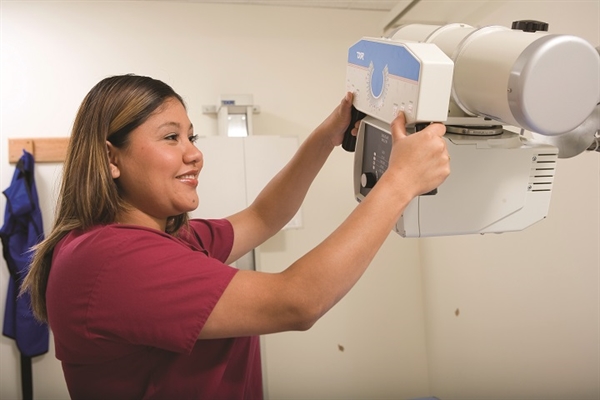The week of November 8-14th, 2020 is National Radiologic Technology Week, commemorating the discovery of the x-ray by Wilhelm Conrad Roentgen on Nov. 8, 1895. This annual event celebrates the vital work radiologic technicians (RTs) perform for patients in a variety of settings.
RTs are frontline caregivers who use x-rays to capture pictures of bones as well as of ligaments, muscles and other organs to aid in a diagnosis. Sometimes referred to as Rad Techs, these skilled workers operate x-ray machines and are members of a specialization that includes operators of related imaging equipment such as advanced CT (computed tomography), magnetic resonance imaging (MRI), and ultrasound machines. In a typical day, an RT will perform several types of tasks. For example, prior to patients’ arrivals, and before taking any images, the RT will check the equipment to ensure it is functioning properly.
According to the U.S. Bureau of Labor Statistics, 61 percent work at hospitals, 18 percent work at diagnostic labs, 14 percent work at physician’s offices, and 3 percent work at outpatient care centers.
When a patient comes into the facility, the RT provides them with a medical gown, if needed, and instructs them on how to prepare for procedure. Once the patient is ready, the RT will position the patient and equipment so they can get the images that the doctor ordered. If the patient needs help moving into the necessary position, the RT may need to assist them.
Once the patient and equipment are positioned, the RT will take precautions against unnecessary exposure to radiation. This could include draping a lead-lined gown or blanket over the patient’s vital organs as well as reproductive areas.
The RT will then take the images with equipment that is usually computerized. He or she will review the images to ensure they are of the prescribed area and that they are clear enough to give the physician the information needed to make a diagnosis. In some cases, the RT may need to take additional images if the physician requires more information or images from multiple angles.
When the RT is finished with the patient, they will take the patient back to a changing room and give them information on what to expect next. After leaving the patient, they’ll return to the imaging room and wipe down the equipment and examining table and prepare for the next patient.
When the x-ray process is complete, the RT will process the images, which are often stored as digital files. This makes it easy for a doctor to access. information and allows them to be easily linked to the patient's medical records.
By providing physicians with the information they need to diagnose and treat patients, RTs are an integral part of a healthcare team. If training for a career in Radiologic Technology sounds interesting to you, Fortis offers Radiologic Technology, as well as other medical technology programs including Surgical Technology (#surgtech), and Cardiovascular Technology at select campuses. Check out our Radiologic Technology program page for more information.

